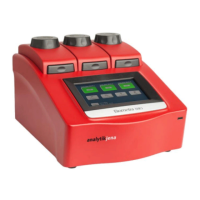Biometra TRIO Installation and commissioning
Version 03_19 19
4 Installation and commissioning
4.1 Content of delivery
Thermal Cycler
Mains connector
Manual
Short Manual
Please keep the original packaging material for return shipment in case of servicing.
The Biometra TRIO Thermal Cycler shipping box provides a specially developed system
with form blocks for a safe transport of this electronic device.
4.2 Unpack and Check
Unpack and carefully examine the instrument. Report any damage to Biometra.
Please keep the original packing material for return shipment in case of service issues.
4.3 Installation Conditions
Place the Biometra TRIO Thermal Cycler on a stable surface in a dry, safe environ-
ment. For details see working conditions in table "Technical specifications" (see
chapter 18 p. 107 ).
Let equilibrate the Biometra TRIO Thermal Cycler to room temperature before
starting operation (1 to 6 h).
Make sure that the appliance connector and the plug of the supply cord are acces-
sible, so you can separate the instrument from the mains.
Make sure that the ventilation slots on the bottom and the rear are not obstructed
(see Figure 3 p. 21). Make sure that there is no object underneath the Thermal Cy-
cler that may block the ventilation slots at the bottom (e.g. a piece of paper etc.)
There must be sufficient distance between the ventilation slots on the rear side of
the Thermal Cycler and a wall or another instrument (min 10 cm).
In case of several cyclers side by side running simultaneously we would recommend
to keep a distance of at least 10 cm between every thermal cycler.
Ensure that both the rear and bottom ventilation slits of the rear and bottom of the
instrument are unobstructed. Insufficient ventilation can cause overheating of the
instrument.

